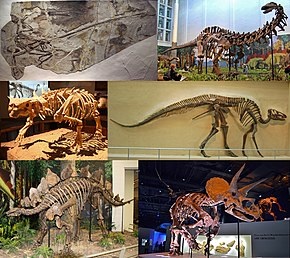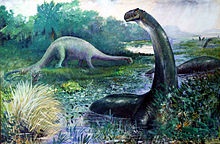|
|
| |
|
|
| |
|
|
|
|
| |
 |
A compilation of
dinosaur skeletons. Clockwise from top left:
Microraptor gui (a winged theropod)
Apatosaurus louisae (a giant sauropod)
Edmontosaurus regalis (a duck-billed ornithopod)
Triceratops horridus (a horned ceratopsian)
Stegosaurus stenops (a plated stegosaur)
Pinacosaurus grangeri (an armored ankylosaur). |
Dinosaurs
Dinosaurs and Dinosauria (Latin: Dinosaurium; meaning
"terrible lizards") are a varied group of Archosaur
reptiles. They were the dominant land animals of the
Mesozoic era. Over 500 different genera of dinosaurs are
known. Fossils of dinosaurs have been found on every
continent, and there are still frequent new discoveries.
Dinosaurs appeared in the Upper Triassic, about 230
million years ago. The earliest date of a dinosaur
fossil is that of Eoraptor and Herrerasaurus from the
Argentine, and Saturnalia from Brazil, 237 to 228 mya.
By the early Jurassic they were the top land
vertebrates, and dominated most environments on land.
They continued until the sudden K/T extinction event 66
million years ago.
From the fossil record, we know that birds are living
feathered dinosaurs. They evolved from the earliest
theropods during the Jurassic. They were the only line
of dinosaurs to survive to the present day.
Dinosaurs had adaptations which helped make them
successful. The first known dinosaurs were small
predators that walked on two legs. All their descendants
had an upright posture, with the legs underneath the
body. This transformed their whole life-style. There
were other features. Most of the smaller dinosaurs had
feathers, and were probably warm-blooded. This would
make them active, with a higher metabolism than modern
reptiles. Social interaction, with living in herds and
co-operation seems very likely for some types.
The first fossils were recognised as dinosaurs in the
early 19th century. Some of their bones were found much
earlier, but were not understood. William Buckland,
Gideon Mantell and Richard Owen saw these bones were a
special group of animals. Dinosaurs are now major
attractions at museums around the world. They have
become part of popular culture. There have been many
best-selling books and movies. New discoveries are
reported in the media. |
|
Types of dinosaurs
Dinosaurs are united by at least 21 traits in their
skulls and skeletons. These common characters (called 'synapomorphies')
are the reason palaeontologists are sure dinosaurs had a
common origin.
However, when definite dinosaur fossils appear (early in
the Upper Triassic), the group had already split into
two great orders, the Saurischia, and the Ornithischia.
The Saurischia keep the ancestral hip arrangement
inherited from their Archosaur ancestors, and the
Ornithischia have a modified hip structure.
Dinosaur origins and
evolution
Earliest dinosaurs
The first known dinosaurs were bipedal predators that
were one to two metres long.
The earliest confirmed dinosaur fossils include the
saurischian ('lizard-hipped') dinosaurs Herrerasaurus
230–220 mya, Staurikosaurus possibly 230–225 mya,
Eoraptor 231.4 mya, and Alwalkeria 230–220 mya.
Saturnalia, 232–225 mya, may be a basal saurischian or a
prosauropod. The others are basal saurischians.
Among the earliest ornithischian ('bird-hipped')
dinosaurs is Pisanosaurus 230–220 mya. Although
Lesothosaurus comes from 199–189 mya, skeletal features
suggest that it branched from the main Ornithischia line
at least as early as Pisanosaurus.
Early saurischians were similar to early ornithischians,
but different from modern crocodiles. Saurischians
differ from ornithischians by keeping the ancestral
configuration of bones in the pelvis (shown in a diagram
above). Another difference is in the skull: the upper
skull of the Ornithischia is more solid, and the joint
connecting the lower jaw is more flexible. These
features are adaptations to herbivory; in other words,
it helped them grind vegetable food.
Adaptive radiation
Dinosaurs were a varied group of animals. Adaptive
radiation let them live in many ecological niches.
Paleontologists have identified over 500 different
genera and 1,000 species of non-avian dinosaurs. Their
descendants, the birds, number 9,000 living species, and
are the most diverse group of land vertebrates.
The largest dinosaurs were herbivores (plant-eaters),
such as Apatosaurus and Brachiosaurus. They were the
largest animals to ever walk on dry land. Other
plant-eaters such as Iguanodon had special weapons, to
help them fight off the meat-eaters. For example,
Triceratops had three horns on its head shield,
Ankylosaurus was covered in boney plates, and
Stegosaurus had spikes on its tail.
The carnivores were bipedal (walked on their back legs),
though not as we do. Their body was more towards the
horizontal, balanced at the back by their tail. Some
were very large, like Tyrannosaurus, Allosaurus and
Spinosaurus, but some were small, like Compsognathus. It
was the smaller sized meat-eaters that may have evolved
into birds. The first fossil bird, Archaeopteryx, had a
skeleton which looked much like that of a dinosaur. |
|
 |
| This 1897
restoration of Brontosaurus as an aquatic,
tail-dragging animal, by Charles R. Knight,
typified early views on dinosaur lifestyles. |
Lifestyle
Locomotion
Dinosaurs were primitively bipedal: their probable
ancestors were small bipedal Archosaurs. The date of the
early dinosaur genus Eoraptor at 231.4 million years ago
is important. Eoraptor probably resembles the common
ancestor of all dinosaurs; its traits suggest that the
first dinosaurs were small, bipedal predators. The
discovery of primitive, pre-dinosaur, types in Middle
Triassic strata supports this view. Analysis of their
fossils suggests that the animals were indeed small,
bipedal predators.
Those dinosaurs which returned to four-legged stance
kept all four legs under their body. This is much more
efficient than the sprawling legs of a lizard.
The big sauropods could never have reached so large a
size without their pillar-like legs. A review surveys
what we know about the mechanics of dinosaur movement.
Warm blooded
A major change in outlook came in the 1960s, when it was
realised that small theropods were probably
warm-blooded. The question of whether all theropods or
even all dinosaurs were warm blooded is still undecided.
It is now certain (from fossils discovered in China: see
Jehol biota) that small theropods had feathers. This
fits well with the idea that they were warm-blooded, and
that the origin of birds can be traced to a line of
small theropods.
Activity
Warm blooded animals have a high metabolic rate (use up
food faster). They can be more active, and for longer,
than animals who depend on the environment for heating.
Therefore, the idea of warm-blooded dinosaurs insulated
by feathers led to the idea that they were more active,
intelligent and faster runners than previously thought.
Main-stream palaeontologists have followed this view for
small theropods, but not for larger herbivores. Since we
know that the size of a Stegosaur's brain was about the
size of a walnut, there is good reason to think its
intelligence was limited.
Limitations
Despite their great success over a long period, there
were life-styles which the dinosaurs never evolved. None
ever evolved to live entirely in water, as many mammals
do, though Spinosaurus was semi-aquatic. They never
dominated the small terrestrial niche. All through the
Mesozoic most small vertebrates were mammals and
lizards. |
|
 |
| The battles that may
have occurred between Tyrannosaurus rex and
Triceratops are a recurring theme in popular
science and dinosaurs' depiction in culture. |
Extinction
The extinctions at the end of the Cretaceous were caused
by one or more catastrophic events, such as massive
asteroid or meteorite impacts (like the Chicxulub
impact), or increased volcanic activity.
Several impact craters and massive volcanic activity,
such as that in the Deccan Traps in India, have been
dated to the approximate time of the extinction event.
These geological events may have reduced sunlight and
hindered photosynthesis, leading to a massive disruption
in Earth's ecology.
Did any terrestrial dinosaurs survive the great
extinction event? Several fossils have been found in the
Hell Creek Formation about 40,000 years later than the
K/T extinction event. Many scientists dismiss the
"Paleocene dinosaurs" as re-worked, that is, washed out
of their original places and then re-buried in much
later sediments. An associated skeleton (e.g. more than
one bone from the same individual) found above the K/T
boundary would be convincing, but no such finds have
been reported.
Dinosaurs in fiction
"...Dragons of the prime,
that tare each other in their slime".
Tennyson, In Memoriam,1849.
Books about dinosaurs have been popular, especially with
children, but adults have also enjoyed these kinds of
books. In Edwardian times, Arthur Conan Doyle wrote a
novel about a plateau filled with dinosaurs which he
called The Lost World.
Jurassic Park in 1990 started a new phase in dinosaur
popular culture when it was followed by the movie of the
same name in 1993. |
|
|
 Kiddle: Dinosaurs Kiddle: Dinosaurs
Wikipedia: Dinosaurs |
|
|
|
|
|
|
|
|
|
|
|
|
|
|
|
|
Search Fun Easy English |
|
|
|
|
|
|
|
|
|
|
|
|
|
|
|
About
Contact
Copyright
Resources
Site Map |